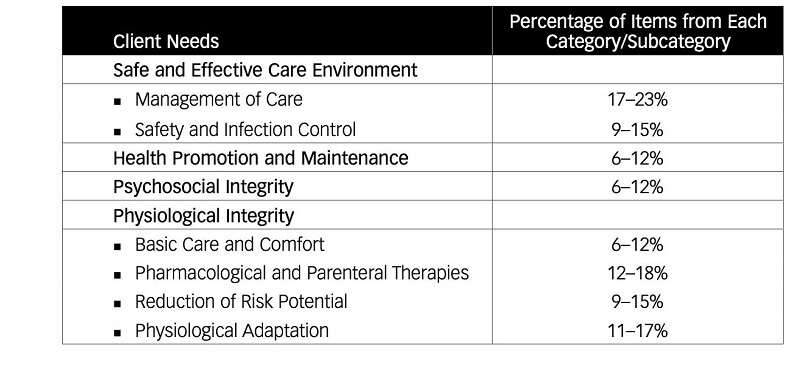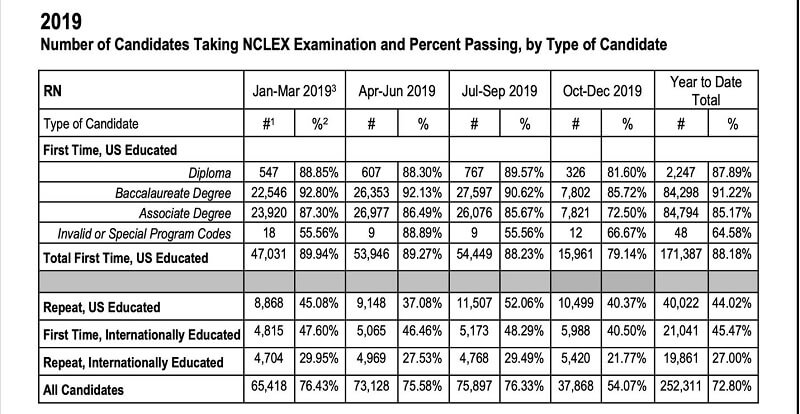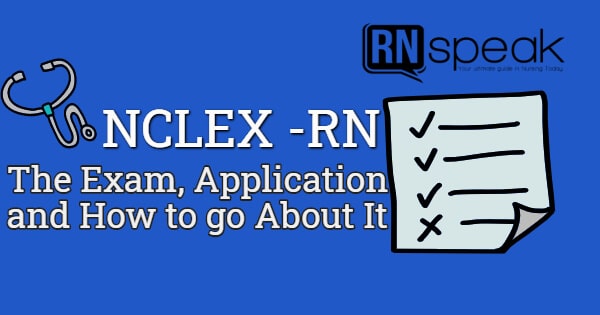One of the most common long-term goals that nurses set for themselves after graduation is to find a stable job, whether in the United States or abroad.
The United States is one of the most common countries on most nurses’ wish lists because they are provided with more opportunities for professional growth and advancement in addition to better pay. However, before turning their dreams into reality, aspiring nurses must first pass the NCLEX for Nurses or the NCLEX-RN.
The NCLEX-RN
The NCLEX-RN is an examination that is aimed to gauge the entry-level competencies of nurses who want to practice in the United States. It is administered across various testing centers in all US states and over 190 countries worldwide in computerized adaptive testing (CAT) format. The examination itself is administered through Pearson VUE via the Pearson Professional Centers. However, the test itself is owned by the National Council of State Boards of Nursing or the NCSBN.
The NCLEX has two levels of entry-level nursing examinations: the NCLEX-PN and the NCLEX-RN. The NCLEX-PN is administered across the United States and its other territories for nurses who wish to practice as licensed practical nurses (LPN) or licensed vocational nurses (LVN). The NCLEX-RN, on the other hand, is the examination that nurses take as an entry-level requirement to practice as a registered nurse in the United States and its territories.
The examination has also been offered to those aiming to work as registered nurses in Canada since 2015. To date, 10 Canadian provinces offer the test as an entry-level requirement for RNs. While the exam is also owned by NCSBN and administered via Pearson Professional Centers, there are several differences that the Canadian version has over the US version. For one, the exam is available in Canadian French for examinees who prefer to take it in the said language. Another would be the changes in spelling, terminologies, and even trade names of drugs in the examination to fit the Canadian examinee.
The Test Framework
The NCLEX-RN examination measures the entry-level competencies of the examinee. It means that the exam assesses the basic nursing knowledge expected for all graduates. These are expressed in questions directed to determine a certain level of cognition, understanding, and application of various nursing concepts.
Questions are expressed in patient care situations, questions testing recall and memory, and those that assess how a nurse applies knowledge from nursing and other sciences.
The test framework includes four major client needs areas. These are:
a. Safe and Effective Care Environment
b. Health Promotion and Maintenance
c. Psychosocial Integrity
d. Physiological Integrity
As shown in the table below, these four major client needs areas are further subdivided and covered in the following sub-sections to further elaborate on the contents.

Safe and Effective Care Environment
This category, which accounts for roughly one-fourth to one-third (20-34 percent) of the total NCLEX-RN test questions, assesses the nurse’s ability to provide safe and effective care for patients in various situations.
These include questions about safety issues and protocols in various patient care settings, medication administration guidelines, preventing injury and the adverse effects of therapy on patients, and ensuring that the patient with mental health problems does not harm himself or others. While some of these questions may be asked as stand-alone items during the examinations, others will focus on how safe and effective care environments are integrated into the situational analysis.
In some cases, questions about laboratory testing and how the nurse performs roles unique to the profession in obtaining samples, transporting them, and ensuring that the results are relayed correctly related to the patient’s condition are elevated. Other aspects of care covered in this category include following ethical and legal protocols when caring for patients and how nursing administration and management issues can affect overall care safety.
The majority of questions in this category are distributed at random throughout the examination and may come in situational analysis, objective-type questions, or innovative items.
Health Promotion and Maintenance
The category of Health Promotion and Maintenance accounts for approximately 10-12 percent of the total pool of NCLEX-RN test questions. This category assesses the ability of an entry-level nurse to use health education and promotion skills while caring for her patients.
Situations in this category include how the nurse can discuss and educate patients about reproductive health and various methods of birth control; the various stages of pregnancy, labor, and delivery; stages of growth and development inside and outside the uterus; caring for newborns and infants; and how the patient can keep himself or his significant others from developing illnesses or suffering.
Because this category is also integrative, meaning it combines the nurse’s health education skills and understanding of the topic to be discussed with the patients, it is also essential for the nurse to have mastery of the subjects being taught to the patients.
The majority of questions in this category relate to proper home-care instructions, dietary and activity restrictions, complications prevention, stress management techniques, and teaching patients when to alert their care providers based on the signs or symptoms they are experiencing.
This category includes items dealing with the patient’s mental health and psychiatric problems. It accounts for approximately 12-13 percent of the total number of questions in the NCLEX-RN test pool. The category assesses the nurse’s knowledge of these conditions in various care settings, including the home, community, and facilities.
Questions include those suffering from psychiatric disorders such as schizophrenia and those suffering from mental health issues such as anxiety and depression.
The ability of the nurse to teach and guide patients in determining the best coping mechanisms for various stresses and anxieties, stress management techniques, and how to assess patients for signs of increasing severity of mental health problems is also tested.
This category also includes questions about depression, anxiety disorders, schizophrenia, subtypes, eating, body dysmorphic disorders, substance abuse, crises, and organic brain syndromes. Throughout this category, the nurse’s therapeutic communication principles must be followed when interacting with the patient and his family.
Physiological Integrity
The category of Physiological Integrity includes questions about medical-surgical nursing concepts. It covers the most significant portion of the NCLEX-RN test question pool, approximately 44-67 percent of all questions that may be given to an examinee.
It does, however, include questions about pediatric patients’ medical conditions, geriatric and gerontologic conditions, and caring for patients at various stages of cancer. Topics in this category deal with patient conditions that the nurse regularly encounters, such as those with cardiovascular problems like myocardial infarction or hypertension, diabetes and its complications, patients with kidney disorders and dialysis, and other common medical conditions.
The same is true in pediatric patient situations. The management of these conditions, particularly those requiring independent nursing interventions, focuses on the included questions. The nurse assesses for early signs of disease conditions or their complications.
Test Format and Type of NCLEX-RN Questions
Number of items
The minimum number of questions an examinee can take when sitting for the exam is 75, and the maximum number is 265.
Test time
Each examinee has a maximum time limit of 6 hours to complete the test, but there is no minimum time limit.
Because the exam is computer-adaptive, each examinee is presented with questions tailored to how well or poorly they performed on previous questions.
Additionally, an examinee will be required to take a break if they reach the 2.5-hour mark from the start of the test. This would be a ten-minute break, and the time spent on the break would not be included in the total time. Another break may be taken at the four-hour mark if the examinee needs it, but this additional break period will be deducted from the total test time.
Trial Questions
There are approximately 15 “trial” questions scattered throughout an examinee’s test. These questions will be included in the next revision of the test question pool and evaluated for examinee response. However, because these “trial” questions will not be revealed to the examinee during the test, each question must be answered correctly.
Computer Shut Down
The examination is also intended to assess an entry-level nurse’s knowledge based on the percentage of correct answers provided by the examinee to computer-generated questions.
As a result, the computer may shut down on the examinee anywhere between 75 and 265 questions, or until the allotted time of 6 hours has been completely consumed. Shutting down the computer screen during the exam, on the other hand, is not an indication of passing or failing the test, so the nurse should still wait for the quick results or the release of the official results to find out whether the examinee passed or failed.
The Questions
NCLEX-RN questions are expressed differently to capture different types of learners among nurses and ensure that nurses can provide correct answers to questions based on their ability to analyze, integrate, and apply their knowledge rather than simply selecting an answer from memory. These questions are presented in the form of multiple-choice answers.
New NCLEX-RN Exam Format
The NCSBN has also included what was previously known as innovative item questions or questions not expressed in traditional wording.
These are questions with multiple answers, select-all-that-apply responses, illustrations where an examinee clicks on a part that refers to the answer to the question, or answer boxes where the examinee types the answer into the computer.
3 Levels of NCLEX-RN Examination
There are three levels of questions for the NCLEX-RN. The most basic level of questions is
Level 1, which composes approximately 10 percent of all the questions in the NCLEX-RN question pool. These fundamental questions assess the nurse’s recall and recognition of concepts, so they are the most straightforward questions to answer.
Therefore, level 2 questions seek to determine the ability of the examinee to understand concepts and are expressed in items requiring the nurse to analyze and choose the best possible answer from a set of choices. These questions are harder to answer than the previous level.
The last level, Level 3, is the hardest of all and includes the most complex questions in the NCLEX-RN examinations. These questions are designed to evaluate the nurses’ ability to apply concepts, decide on the best course of action in caring for patients, and even plan to anticipate a potential care issue or complication. In most cases, Level 3 questions also come with more than one correct answer among the choices provided, and the examiner is asked to choose the best among these options.
The computer-adaptive system determines the mix and number of Levels 1, 2, and 3 questions given to an examinee during the test. There is no assurance as to the number of questions per level a person may receive. In some cases, an examinee may get all Level 2 and 3 questions without getting a Level 1 throughout the exam.
Scoring the NCLEX-RN Exam
The NCLEX-RN examination comprises multiple-choice questions where there can only be one correct answer and as scored as such. However, with the introduction of the innovative item questions, some items may have multiple correct answers. These items are scored on an all-or-nothing principle where the score is given whether the examinee gets all the right answers or not. No partial points or credits are given.
The NCLEX-RN Passing Rate
The NCSBN collects statistics for the passing rate of all NCLEX-RN examinations conducted in the US and other parts of the world. These are collected and collated every quarter and consolidated every year to give nurses, State Boards, educators, and examiners. The table below is the 2019 statistics:

The table shows the number and percentages of nurses who take the NCLEX-RN. For US-educated nurses, the statistics show that they are grouped according to their nursing education. It can be seen that there is a higher passing rate for all first-time US-educated nurses taking the exam in 2019 at 88.18%. However, US-educated nurses who failed their exams for the first time they took their examination and repeated the test only have a passing rate of 44.02%.
Foreign-educated nurses who pass the examination the first time are at 45.47%, while repeat examinees are only 27%.
On the Day of the Test
The NCLEX-RN is an examination, and there is a very high possibility that the examinee will feel nervous and anxious during the day of the test. While some nerves and anxiety are expected and even considered normal, this should not affect how a person will perform on the exam. Below are a few tips for managing it.
1. Dress appropriately. The testing center does not allow an examinee to wear scarves, bonnets, hats, or even gloves. Coats and jackets are also not allowed, and these are asked to be left outside the testing room. It is advised that an examinee wears comfortable clothing during the test.
2. Be at the testing center 30 minutes ahead of time. The test is given on time, and if an examinee arrives more than 30 minutes behind schedule, the exam is forfeited. The examinee needs to register for a new exam and pay the necessary fees.
3. Be prepared to have biometrics taken. Before being ushered into the exam room, biometric information would be taken from the examinee, such as photographs, fingerprints, signatures, and even palm vein scans.
4. Get seated in the examination room. After all preliminary steps are taken, the examinee is taken to the exam room. Materials such as pen and paper or a note board may help take notes during the test. These materials are returned after the test is finished.
5. Ensure adequate time and pacing during the exam. It is advised that the examinee keeps in mind that the test has a maximum time limit, and therefore the nurse should set a pace accordingly so that the exam time does not run out. It should also be remembered that computer-adaptive testing does not allow the examinee to return to previous questions. Hence, it is vital that all answers that are entered be the final answer for an item.
6. Wrap up. Once the time allotted is fully consumed or the computer shuts down on the examinee, the next would be a short survey that the NCSBN asks all examined to answer. After this is over, the examinee is expected to notify the proctor that the exam is already done by raising a hand. The proctor then ushers the examinee out of the room and is advised to wait for the results.
Registering for the NCLEX-RN Examination
Before reviewing and examining, an applicant must know the requisites that need to be submitted to qualify for the exam. These requisites vary from one State Board of Nursing to another, and there are sometimes particular guidelines that a State Board has for its applicants.
For example, in the State of California, the California Board of Nursing (CBRN) may require a foreign-educated nurse to undergo a bridging program where applicants will need to enroll themselves in an accredited school of nursing to ensure that they have the same knowledge and training with the graduates of State of California.
The registration for the examination starts with knowing the State Board of Nursing’s requirements of the US state where the applicant wishes to be licensed in and take the exam. This can be obtained from the specific Board of Nursing’s website, listed in the National Council of State Boards of Nursing (NCSBN).
Following the State Board’s guidelines, an applicant should take the following steps to ensure a successful application:
- Ensure that all documents required by the State Board are prepared and in the forms that they will accept (i.e., electronic via PDF; Certified True Copy; Certified Photocopy; etc.). These documents may include:
- Certification of English language proficiency such as IELTS or TOEFL;
- Clinical Experience and/or Clinical Case records;
- US-issued Social Security Number or SSN (In some States, they may still allow a foreign-educated applicant to register and take the examination even without the SSN, but they will not issue the license without it.)
- A valid Credential Verification or Evaluation. This can be processed through the CGFNS VisaScreen service or with a State Board’s accredited provider.
- Registration with Pearson VUE to sit and take the NCLEX-RN Examination. This is done after the State Board notifies the applicant of his eligibility to take the examination.
- Obtaining the Authorization to Test (ATT) from Pearson VUE. The ATT is valid for 90 days upon receipt, so it is important to schedule the examination date once this is received. This can be done in one of the following ways:
How much are the licensure fees?
Online Registration via https://www.pearsonvue.com/nclex and paying the $200 testing fee via check, credit card, or money order. The instructions on payment methods are discussed on the site.
Register via telephone call through dialing Pearson VUE NCLEX Candidate Services at 1-866-496-2539.
Though Mail by mailing the registration form and payment.
- Ensure scheduling the examination on the date, time, and testing center accessible to the applicant.
The Pearson VUE Refund Policy
The examinee needs to be sure of the schedule of the intended testing. This is because the NCBN is very clear in stating that there will be no processing of refund requests from an examinee, especially if the nurse:
- Has entered multiple registrations, especially if these registrations pertain to the same examination;
- Failed to confirm the schedule of an examination within 24 business hours since it has been made;
- Failed to cancel an examination within the 24 business hour window since the registration has been made; and
- Not appearing at the testing center on the date and time of the scheduled examination.
Because of these strict rules, the examinee should contact the NCLEX Candidate Services at the NCSBN if the nurse has not received any confirmation of registration two weeks after registration approval has been submitted.
These rules apply to both US-educated and based nurses and nurses who were educated and living outside the US.
Taking the Examination and Awaiting Results
Applicants who have already confirmed their schedules to sit for the exam may take it in any Pearson Professional Testing Centers in the USA or any country with a Pearson VUE Center. In the Philippines, there is a center located in Makati City, and Filipino nurses can schedule and take their examinations there.
Because of the Quick Results service of a majority of State Boards, applicants can check their examination results 2-3 days after the date the test was taken. However, applicants should also remember that it would take at least 4-6 weeks before the official results of the exams are emailed to the candidate.
In Case of Failure on the Exam
In the unfortunate event, however, that the candidate failed the NCLEX-RN examinations, the NCSBN would only accept applications to retake the test after three months or 90 days from the exam day.
Conclusion
The NCLEX-RN examination should not be seen as a hurdle to stop a nurse from practicing in the USA. Instead, it should be viewed as an entry-level requirement that all RNs must pass to practice the profession in the United States lawfully. This exam is used to determine if a nurse possesses all entry-level competencies expected of a bachelor’s degree graduate.
Like any exam, the NCLEX-RN should be taken after a thorough preparation since taking it prepared is the best way to pass it and earn that coveted USRN license.




![13 Free Online Continuing Professional Development (CPD) Resources for Nurses [2025] free cpd for nurses](https://rnspeak.com/wp-content/uploads/2020/07/free-cpd-for-nurses-238x178.jpg)



